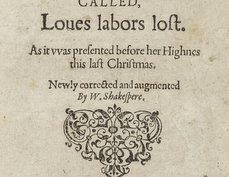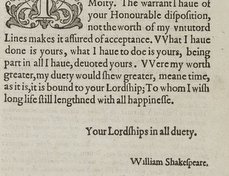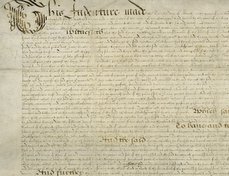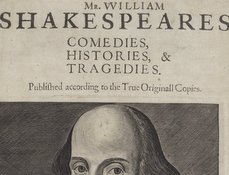Lay subsidies were a type of tax based on personal wealth. In London, the collection of subsidies was managed at the local level of ward and parish. Names listed in lay subsidy rolls created from these tax collections constitute a kind of census of families of substance in each parish.
Each collection typically generated one lay subsidy roll and one default roll for each ward. The lay subsidy roll listed all householders whose wealth was estimated at £3 or more. The same roll recorded the estimated wealth and the assessed subsidy of each householder. The default roll listed all those who did not pay. After being included in the default roll, defaulters were listed in Remembrancer Rolls, legal instruments dedicated to the recovery of crown debts.
Five extant documents, from the years 1597 to 1600, track Shakespeare’s lay subsidy taxations and defaults in the parish of Saint Helen’s Bishopsgate.
From a presumptive seven original lay subsidy rolls for Bishopsgate ward 1593 to 1600, three rolls survive: for 1598, 1599, and 1600. The name “William Shakespeare” occurs among the seventy-odd parish householders listed in the intact roll for 1598 but does not occur in the intact roll for 1600. The St. Helen’s parish list from the 1599 roll is so decayed as to be illegible.
Against William Shakespeare’s name in the 1598 roll is written “Affid.” for “Affidavit.” This notation signifies that for some reason money was not collected, and the collectors offered to swear an oath or “affidavit” absolving themselves of the responsibility to make payment from their own purses.
The vehicle for swearing the affidavit is called a “default roll.” A default roll with the name “William Shakespeare” survives from the 1597 collection for St. Helen’s parish. There is no year where both the lay subsidy roll and default roll naming Shakespeare survives.
Both the 1597 default roll and the 1598 lay subsidy roll record an assessment of William Shakespeare’s wealth at £5. While about half the members of the parish were assessed at £3, and several were assessed at £5, many were assessed at £10 or £20, and a few at £100 or more. Sir John Spencer, whose wealth was legendary (ODNB), was assessed at £300. Lay subsidy assessments should not be taken literally, and it should not be assumed that Shakespeare’s annual income in 1597 and 1598 was only £5. Although most parishioners probably under-reported their total wealth, the assessments must have been roughly proportional to actual wealth, meaning that Shakespeare stood just above the mean for the parish, not counting those too poor to pay anything at all.
If Shakespeare had already defaulted in 1597, perhaps because he had already left the parish, why was his name included in the roll of householders from 1598? Since each roll was based upon an earlier roll, it might take some time to purge a name from a list of active householders. We may cautiously infer that Shakespeare had been an active householder in St. Helen’s parish sometime prior to, but no later than, November 15, 1597.
In 1597 William Shakespeare was to pay a tax of 5s. In 1598, calculated at a different rate, he was to pay 13s 4d. The 1597 default of 5s is not heard of again.
Three documents from the exchequer, or royal treasury, from 1598-9, 1599, and 1600, track Shakespeare’s 1598 debt of 13s 4d. The same documents reveal that Shakespeare was one of hundreds of defaulters. The “Lord Treasurer’s Remembrancer” roll from 1598-9 explicitly confirms Shakespeare’s former connection to the parish of St. Helen’s Bishopsgate. The same debt is carried over on similar rolls dated October 6, 1599, and October 6, 1600. These various documents reveal that the debt was first transferred to the county of Sussex, which for tax purposes was sometimes amalgamated with the county of Surrey; then to the county of Surrey itself; and finally to the jurisdiction of the Bishop of Winchester, whose diocese included the liberty of the Clink, Bankside, Southwark, by this date the site of the Globe playhouse.
Like the 1597 debt of 5s, the 1598 debt of 13s 4d eventually disappeared from the records, the latter after 1600. Perhaps Shakespeare successfully argued that his taxable residence was in Stratford-upon-Avon, not London. Unfortunately, the Stratford subsidy rolls or the related “Certificates of residence” which might have confirmed this speculative possibility have been lost. Considering that Shakespeare purchased New Place in Stratford in 1597, it is unlikely that he was unable to pay the small debt of 13s 4d in the years of his highest income.
Not only Elizabethan officials, but modern scholars have taken up the search for William Shakespeare in Surrey, especially in the parish of St. Saviour, Southwark. Scholars have not found William as a resident, but have found his brother Edmund Shakespeare, a player who briefly inhabited a tenement called the Vine, liberty of the Clink, prior to his burial in the parish church on December 31, 1607.
The possibility that Shakespeare took up residence in Surrey, on the south side of the Thames, in or about 1597, some two years before the Globe playhouse was created, is enhanced by another document, the so-called Langley Writ.
The five documents relating to William Shakespeare as a taxpayer and tax defaulter are:
- Exchequer, King’s Remembrancer, Default Roll 39 Elizabeth (November 15, 1597)
- Exchequer, King’s Remembrancer, Subsidy Roll 40 Elizabeth (October 1, 1598)
- Exchequer, Lord Treasurer’s Remembrancer, Accounts of Subsidies: defaults for subsidies granted in 1593 and 1597 (October 1, 1598)
- Exchequer, Lord Treasurer’s Remembrancer, Pipe Rolls: headed “Residuum London” (October 6, 1599)
- Exchequer, Lord Treasurer’s Remembrancer, Pipe Rolls: headed “Residuum Sussex” (October 6, 1600)
Written by Alan H. Nelson
Sources
B. Rowland Lewis, Shakespeare Documents, (Stanford University, California: Stanford University Press, 1940), 1: 262-71.
Samuel Schoenbaum, William Shakespeare: A Documentary Life (New York: Oxford University Press, 1975), 161-4.
David Thomas, Shakespeare in the Public Records, (London: H.M.S.O., 1985), 6-8.
M. Jurkowski, C.L. Smith, and D. Crook, Lay Taxes in England and Wales 1188-1688 (Richmond Surrey: PRO Publications), 1998.









